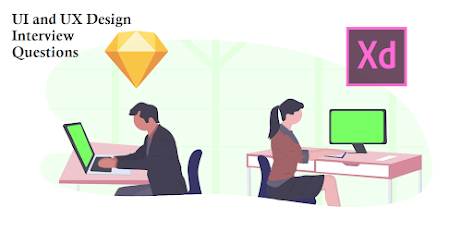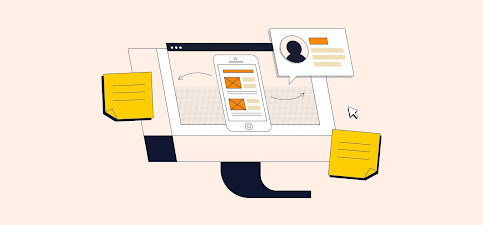20 UI and UX Design Interview Questions with Answers
You have every reason to thank yourself for coming here. Whatever you are going to read here is going to change everything as far as UI and UX design interview is concerned. You are not going to fail again because you have come to get a solution at the right time. The top 20 UI and UX design interview questions with answers that will help you pass your interview are as follows1. What are the important skills for a UX Designer?
Answer: The most important skills for a UX Designer are as follows:
- Prototyping,
user flows, wireframing, mockups: UX Designers need to be able to
envision what the product will look like. According to the stage of the
product development process, they’ll need to create wireframes, high or
low-fidelity prototypes, user flows, or mockups.
- Visual design
and design software: UX Designers need to use visual design software to
create the visual design elements of a product. They need to be
proficient in these tools along with knowing typography, color theory,
icons, etc.
- Collaboration: UX Designers have to collaborate with other teams regularly. They need to know how to work as part of a team.
- Communication and presentation: While collaborating, UX Designers have to communicate. Good communication skills are important for them to be able to get better insights from customers as well. Good presentation skills are important to be able to communicate ideas with stakeholders.
2. What distinguishes UI design from UX design?
Answer:
The distinction between User Interface (UI) and User Experience (UX) is
that UI refers to the visual components through which people interact
with a product, whereas UX is concerned with the user's experience with a
product or service.
So, UI is concerned with visual interface elements like fonts, colors, menu bars, and so on, but UX is concerned with the user and their journey through the product. You can further join one of these best UI and UX courses to learn more about difference between UI and UX in depth
3. What are the components of UI design patterns?
Answer:
The problem, context of usage, principle, solution, and implementation
are the essential components of the UI design pattern. These pieces
primarily describe the user's issue with the system and the context in
which it is being used. The user interface—the solution and how the
functionality works—is built using the idea or design pattern. A system
is applied with examples from a real-life system.
4. What are the various user interface frameworks and technologies?
Answer:
The tools for developing software, mobile, and web applications are
referred to as the UI framework. Other technologies that are now widely
used for the front end or user interface include Bootstrap, Angular JS,
and React JS.
5. What are the different stages involved in the process of design thinking?
Answer:
- Empathize – The first step is to empathically understand the problem that needs solving. Here, you would consult experts and observe people’s experiences to fully empathize with them.
- Define – In the second step, you combine the information you collected in the first step. Then you analyze it to define the main problem.
- Ideate – In this step, you start coming up with ideas while keeping the user’s needs in mind.
- Prototype – In the fourth step, the design team comes up with scaled-down versions of the product or the features to see if the solutions work.
- Test – In the final step, you test the product and the features, utilizing the best solutions that were identified in the previous stage.
6. What are some of the UX evaluation methods?
Answer:
- Aesthetics scale – This method identifies the aesthetic quality of websites. It defines the two dimensions of user perception – classical aesthetics and expressive aesthetics.
- Audio narrative – In this method, users narrate their experiences in the form of a story. This story is recorded.
- Controlled observation – People are called to a controlled environment where they test the colors or audio of the system. The data is collected in the form of facial expression videos, etc.
- Emotion cards – Users are asked to test web or mobile applications where they are provided with cards. These cards would either have a preset emotion on them or it’s just a blank field. Users fill them in when they use the product.
- Living lab method – In this method, research is conducted on the behavior of users in their natural living environments. This helps in understanding the process of making technologies that respect life’s complexities.
- Product Personality Assignment – Users go through some product designs and answer a questionnaire assigning different personalities to each design. They also have to explain the reason behind their decision.
7. What are some of the UX-related publications?
Answer:
- UX Magazine
- UXer Talks
- Smashing Magazine
- Awwwards
- Design Shack
8. What are the key differences between designing for desktop and mobile?
Answer:
- Screen size – There is an obvious difference between the screen sizes for desktop and mobile. That affects the layout design. Desktop apps can support fixed navigation bars while mobile apps have to be limited to pull-out menus.
- Interaction – While desktops can take full advantage of the cursors interactivity, mobile apps don’t have that feature. Users have to use gestures like swiping, shaking, or poking in mobile apps.
- Organizing content – In desktop apps, we can use the multi-column format offering way too many options in layouts and positioning. Mobile apps have to resort to scrolling.
- Functionality – Desktops are preferred for longer, more involved tasks while mobiles are preferred for quicker tasks.
9. What are common tools used for prototyping?
Answer:
- Figma – Figma helps UX Designers with better collaboration and accessibility.
- InVision Studio – With InVision Studio, UX Designers can quickly put together functional prototypes and share them with the team.
- Adobe XD – Adobe XD provides users with a vector-based system to put together prototypes.
10. What is Universal design?
Answer:
Universal design is meant to be accessible, usable, and understood by
everyone regardless of their ability, disability, age, or size. A
universal design should be able to meet the needs of everyone who wants
to use it. The two approaches to universal design are as follows:
- User-Aware Design: includes as many people as possible by pushing mainstream product designs.
- Customizable Design: makes sure the design can adapt to the needs of specific users.
11. How would you make a product accessible to differently-abled users?
Answer:
- Adapt to different platforms: It’s important to optimize the website or app so it can work well on various devices.
- Prioritize scalability: Your product needs to be durable. If it crashes during a high influx of activity, you will lose customers.
- Take user feedback: Your product will be universally accessible if it incorporates the needs of the users you are catering to.
12. What are some analytical tools used in conducting UX evaluation?
Answer:
- Crazy Egg – It’s one of the simplest heatmap tools.
- Good Data – It’s a BI solution that is cloud-based. It can combine multiple data sources to provide really helpful reports.
- KISSmetrics – It is useful in creating reports and funnels based on customer behavior.
13. What are some of the KPLs used in conducting UX evaluation?
Answer:
- Task success rate – The task success rate helps you measure the number of correctly executed tasks.
- Time-on-task – This describes the time that a user spends on completing a task.
- User error rate – This is the number of times a user makes a wrong entry.
14. What is a call to action (CTA)?
Answer:
A call to action is one of the most important (and perhaps most
important) elements of a website, platform, app, or digital interface.
In short, this is an interface element that pushes the user to the
desired action: buying a product, downloading a report, reposting an
article, donating money, etc.
15. What is atomic design?
Answer:
This is a fairly young but already very common methodology that Brad
Frost presented to the world in 2013. Atomic design is all about
designing individual elements and their combinations instead of
designing entire web pages. This is a basic explanation of the essence
of the methodology.
16. What are the 5 ingredients of atomic design?
Answer:
- Atoms: The smallest and most basic building blocks. In terms of interfaces, these are fields, text boxes, buttons, etc. They can also include colors, palettes, fonts, etc.
- Molecules: When atoms come together, they form molecules - groups of atoms bound together. These are the smallest and most fundamental parts of the whole. Molecules can have their own special properties.
- Organisms: Organisms are made up of molecules. When molecules are combined into a group, we get a relatively complex and isolated section of the interface - an organism.
- Templates: This stage is understandable even for clients. Templates are groups of organisms organized into pages. This stage allows us to see things like the layout finally.
- Pages: These are specific uses of templates that allow us to see the final version of the interface. Pages are the most sophisticated version of this system, allowing UX and UI designers to test the effectiveness of the design system jointly.
17. What are the three basic principles of usability?
Answer:
- Understandability – Users need to know what they’re doing at every step of the process.
- Learnability – Users must be able to figure out how to perform tasks without having to read instructions.
- Operability – Users must be capable of performing tasks with minimal effort.
18. What is a prototype?
Answer: A prototype is a representation of an object. It is similar to a blueprint.
19. What is a wireframe?
Answer: A wireframe is a visual representation of a website. It shows the basic layout of the site.
20. What is the difference between float and clearfix?
Answer:
- Float: The float property allows a floating box to move around within its parent container.
- Clearfix: The clearfix method is used to make sure that children floats appear after their parents’ floats.
That's all about top 20 UI and UX Design Interview Questions with Answers. Get
everything right in preparation and all will fall in place when that
big day comes. These questions with answers are what will transform your
journey as far as passing that interview and being recruited is
concerned. Wish you success in this journey.
Other Technical Interview questions you may like to prepare
- 10 Frequently asked SQL queries from Interviews
- Top 50 Multithreading Interview Questions
- 21 Frequently asked Java Interview Questions
- Top 30 Array-based Interview Questions
- Top 50 Java Programs from Coding Interviews
- Top 20 LinkedList based Interview Questions
- Difference between Primary and Unique key in SQL
- Top 50 Programming questions for a telephonic interview
- 15 Spring Boot Interview Questions for Java Programmers
- 20+ Spring Boot Interview Questions for Java Programmers
- 21 String Programming Interview Questions with Solutions
- 101 Coding Problems and Tips to Crack Your Next Interview
- 25 Software Design Interview Questions for coders
- Bootstrap Web Design Interview Questions with answers



No comments:
Post a Comment
Feel free to comment, ask questions if you have any doubt.